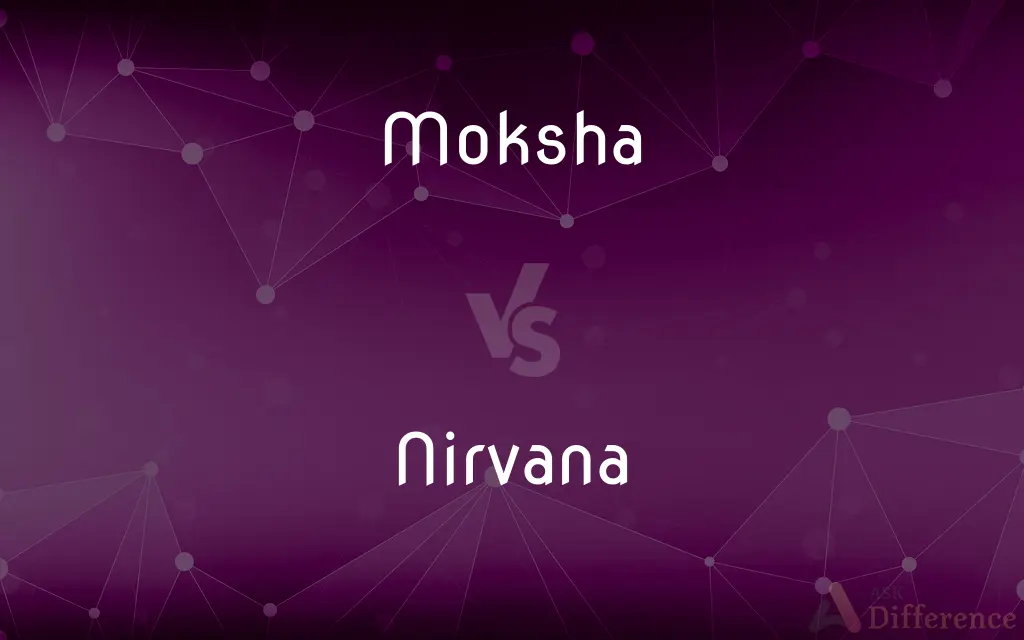Moksha vs. Nirvana — What's the Difference?
Edited by Tayyaba Rehman — By Urooj Arif — Updated on March 14, 2024
Moksha is a concept in Hinduism signifying liberation from the cycle of gone and rebirth, while Nirvana, in Buddhism, represents the extinguishing of desire and suffering, leading to liberation.

Difference Between Moksha and Nirvana
Table of Contents
ADVERTISEMENT
Key Differences
Moksha, central to Hinduism, is the ultimate goal of human life, entailing liberation from samsara, the cycle of gone and rebirth. This liberation is achieved through realization of the self's unity with Brahman, the ultimate reality. Nirvana, in Buddhism, signifies the cessation of the kleshas (afflictions) and the escape from the cycle of suffering (samsara). It is attained through the practice of the Eightfold Path, leading to the extinguishing of desire, aversion, and ignorance.
While moksha emphasizes understanding and merging with the universal soul or Brahman, nirvana focuses on the eradication of desire and the individual self, leading to a state of complete liberation from all forms of suffering. Moksha is attained through various paths such as knowledge (jnana), devotion (bhakti), and righteous action (karma), reflecting the diversity within Hindu practices. Nirvana, on the other hand, is reached primarily through mindfulness, ethical conduct, and mental discipline, as outlined in Buddhist teachings.
The concept of moksha suggests a positive, blissful state of union with the divine, whereas nirvana is often described as a peaceful state of non-existence of suffering, without implying the existence of a universal soul. In the pursuit of moksha, the individual soul (atman) is recognized and ultimately understood to be one with Brahman. In contrast, the concept of anatta (no-self) in Buddhism negates the permanent existence of the soul, focusing instead on the liberation from the illusion of self.
Both moksha and nirvana are end goals that denote freedom from the cycle of birth and rebirth, but the philosophical underpinnings and practices leading to these states reflect the distinct nature of Hinduism and Buddhism. The attainment of either state is considered the highest achievement in their respective traditions, offering liberation from all earthly bonds and the cessation of suffering.
Comparison Chart
Key Concept
Union with Brahman, the ultimate reality
Cessation of kleshas, achieving a state beyond suffering
ADVERTISEMENT
Path to Attainment
Through knowledge, devotion, and righteous action
Following the Eightfold Path
Philosophical Basis
Realization of the self's unity with the universal soul
Eradication of desire, aversion, and ignorance
State Described
Positive, blissful union with the divine
Peaceful, absence of suffering without implying soul
Focus
Understanding and merging with Brahman
Liberation from the illusion of self and suffering
Concept of Self
Atman (soul) recognized and unified with Brahman
Anatta (no-self), negating permanent soul existence
Compare with Definitions
Moksha
Liberation from samsara in Hinduism.
Through meditation, she sought moksha and the ultimate union with Brahman.
Nirvana
The ultimate goal in Buddhism, ending suffering.
The Buddha attained nirvana under the Bodhi tree.
Moksha
Achieved through diverse paths like knowledge and devotion.
He followed the path of bhakti to attain moksha.
Nirvana
A state beyond the cycle of birth and suffering.
Nirvana represents the cessation of all worldly suffering.
Moksha
Represents a blissful state of freedom from rebirth.
In moksha, the soul is liberated from the cycle of gone and rebirth.
Nirvana
Achieved through the Eightfold Path.
Following the Eightfold Path, he aspired to reach nirvana.
Moksha
The highest goal of human life in Hindu traditions.
The sage lived his life in pursuit of moksha.
Nirvana
Reached by extinguishing desire, aversion, and ignorance.
Through diligent practice, she moved closer to nirvana.
Moksha
Entails understanding one's unity with the universe.
Realizing his atman was one with Brahman, he attained moksha.
Nirvana
Denotes liberation without the concept of a universal soul.
In nirvana, there is no self, only the end of suffering.
Moksha
In Indian philosophy and theology, the final liberation of the soul or consciousness from samsara and the bringing to an end of all the suffering involved in being subject to the cycle of reincarnation.
Nirvana
(Buddhism) A state in which the mind, enlightened as to the illusory nature of the self, transcends all suffering and attains peace.
Nirvana
(Hinduism) A state in which the soul, having relinquished individual attachments and recognized its identity with Brahman, escapes samsara.
Nirvana
An ideal condition of rest, harmony, stability, or joy.
Nirvana
(Buddhism) Complete cessation of suffering; a blissful state attained through realization of sunyata; enlightened experience.
Nirvana
State of paradise; heightened or great pleasure.
Nirvana
In the Buddhist system of religion, the final emancipation of the soul from transmigration, and consequently a beatific enfrachisement from the evils of worldly existence, as by annihilation or absorption into the divine. See Buddhism.
Nirvana
(Hinduism and Buddhism) the beatitude that transcends the cycle of reincarnation; characterized by the extinction of desire and suffering and individual consciousness
Nirvana
Any place of complete bliss and delight and peace
Common Curiosities
What is the difference between moksha and nirvana?
Moksha is liberation in Hinduism, emphasizing unity with the universal soul, while nirvana in Buddhism focuses on extinguishing desires and the illusion of self to end suffering.
Are moksha and nirvana states of being or processes?
They are considered states of ultimate liberation but involve processes of spiritual practice and personal development to attain.
What is the significance of the soul in moksha and nirvana?
In moksha, the soul's realization and union with Brahman is central, while nirvana involves the understanding of anatta, or no-self, negating the concept of a permanent soul.
Can nirvana be achieved in life, or only after gone?
In Buddhism, nirvana can be achieved in life, known as nirvana-with-remainder, with the final nirvana (without remainder) occurring upon the gone of the body.
How do moksha and nirvana impact the cycle of rebirth?
Both aim to liberate the individual from the cycle of rebirth—moksha through union with Brahman and nirvana through the cessation of suffering and desires.
Do moksha and nirvana represent the end of existence?
Not necessarily the end of existence, but the end of the cycle of suffering and rebirth, with moksha leading to union with the divine and nirvana to a state beyond suffering.
How does one achieve moksha or nirvana?
Moksha is achieved through knowledge, devotion, and righteous actions in Hinduism, whereas nirvana is attained by following the Buddhist Eightfold Path.
Is the pursuit of moksha or nirvana limited to monks and nuns?
While monks and nuns may dedicate their lives to this pursuit, laypersons in both Hinduism and Buddhism can also strive for moksha or nirvana through their practices and way of life.
How do different schools within Hinduism and Buddhism view moksha and nirvana?
Different schools offer various interpretations and paths to achieving these states, reflecting the diversity within each religious tradition.
Share Your Discovery

Previous Comparison
Corroboration vs. Collaboration
Next Comparison
Help vs. HinderAuthor Spotlight
Written by
Urooj ArifUrooj is a skilled content writer at Ask Difference, known for her exceptional ability to simplify complex topics into engaging and informative content. With a passion for research and a flair for clear, concise writing, she consistently delivers articles that resonate with our diverse audience.
Edited by
Tayyaba RehmanTayyaba Rehman is a distinguished writer, currently serving as a primary contributor to askdifference.com. As a researcher in semantics and etymology, Tayyaba's passion for the complexity of languages and their distinctions has found a perfect home on the platform. Tayyaba delves into the intricacies of language, distinguishing between commonly confused words and phrases, thereby providing clarity for readers worldwide.















































